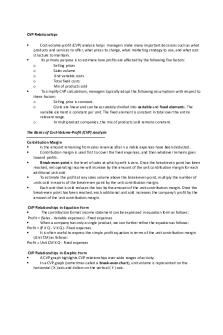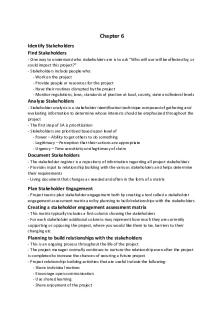CVP MANAGEMENT Chapter 5 summary PDF

| Title | CVP MANAGEMENT Chapter 5 summary |
|---|---|
| Course | Accounting for Business Decisions A |
| Institution | University of Technology Sydney |
| Pages | 8 |
| File Size | 737.4 KB |
| File Type | |
| Total Downloads | 4 |
| Total Views | 167 |
Summary
ACCT3 management chapter 5 summary...
Description
COST-VOLUME-PROFIT ANALYSIS
Focuses on the relationships among the following five factors and the overall profitability of a company: o the prices of products or services o the volume of products or services produced and sold o the per-unit variable costs o the total fixed costs o the mix of products or services produced.
CVP analysis requires projections about the future and uses the following assumptions: The selling price is the same, not looking at the production amount Costs are linear throughout the relevant range The sales mix used to calculate the weighted average contribution margin is constant. The amount of inventory is constant – the number of units produced is equal to the number of units sold. Weighted average contribution margin The sales mix is used to determine the weights of the individual product contribution margins in the overall average contribution margin for a business. Lo1 The contribution margin and its uses The traditional profit and loss statement required for external financial reporting focuses on function (product costs versus period costs) to calculate the cost of goods sold and a company’s gross profit Gross profit o The difference between sales and cost of goods sold. Contributed margin o Sales revenue less variable cost As you can see, although the net profit is the same for both statements, the traditional statement focuses on the function of the costs, whereas the contribution margin profit and loss statement focuses on the behaviour of the costs.
Contribution Margin per unit The sales price per unit of product less all variable costs to produce and sell the unit of product; used to calculate the change in contribution margin resulting from a change in unit sales.
Contributed Margin Ratio The contribution margin divided by sales; used to calculate the change in contribution margin resulting from a dollar change in sales.
Lo2 What if decisions using CVP To increase profits while still keeping the same quality products o Reduce variable costs o Increase sales incentives (commissions) o Change game features and increase advertising Lo3 Break-Even Analysis Break even point o The level of sales at which contribution margin just covers fixed costs and net profit is equal to zero
Break-even calculations with multiple products
Lo4 Target profit analysis (before and after tax)
The Impact Of Taxes
Lo5 Cost Structure and Operating Leverage Labour intensive companies often incur lower fixed costs and higher variable costs than automated or machine-intensive organisations. Operating Leverage The contribution margin divided by net profit; used as an indicator of how sensitive net profit is to a change in sales....
Similar Free PDFs
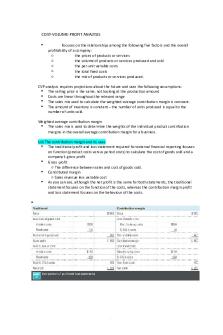
CVP MANAGEMENT Chapter 5 summary
- 8 Pages
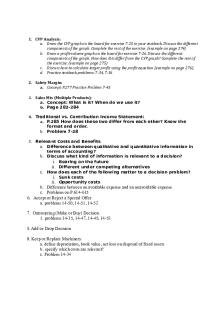
CVP - Chapter 6 on CVP
- 2 Pages

COM 316 Chapter 7: CVP
- 10 Pages

Chapter 22 - CVP Analysis
- 52 Pages

Chapter 5 (Knowledge Management)
- 24 Pages

Chapter 5 Scope Management
- 6 Pages
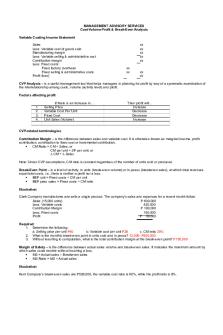
CVP Analysis - CVP
- 9 Pages

5- Summaries chapter 5-Summary
- 5 Pages

Chapter 5 summary
- 7 Pages

Chapter 5 . Metabolism Summary
- 3 Pages

Strategic Management Chapter 5 ppt
- 18 Pages

Blind Spots Chapter 5 Summary
- 1 Pages
Popular Institutions
- Tinajero National High School - Annex
- Politeknik Caltex Riau
- Yokohama City University
- SGT University
- University of Al-Qadisiyah
- Divine Word College of Vigan
- Techniek College Rotterdam
- Universidade de Santiago
- Universiti Teknologi MARA Cawangan Johor Kampus Pasir Gudang
- Poltekkes Kemenkes Yogyakarta
- Baguio City National High School
- Colegio san marcos
- preparatoria uno
- Centro de Bachillerato Tecnológico Industrial y de Servicios No. 107
- Dalian Maritime University
- Quang Trung Secondary School
- Colegio Tecnológico en Informática
- Corporación Regional de Educación Superior
- Grupo CEDVA
- Dar Al Uloom University
- Centro de Estudios Preuniversitarios de la Universidad Nacional de Ingeniería
- 上智大学
- Aakash International School, Nuna Majara
- San Felipe Neri Catholic School
- Kang Chiao International School - New Taipei City
- Misamis Occidental National High School
- Institución Educativa Escuela Normal Juan Ladrilleros
- Kolehiyo ng Pantukan
- Batanes State College
- Instituto Continental
- Sekolah Menengah Kejuruan Kesehatan Kaltara (Tarakan)
- Colegio de La Inmaculada Concepcion - Cebu
